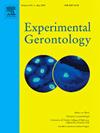具有多种心脏代谢疾病危险因素的老年人循环CD16+单核细胞和TLR4+单核细胞升高
IF 4.3
3区 医学
Q2 GERIATRICS & GERONTOLOGY
引用次数: 0
摘要
我们努力研究健康老年人循环单核细胞表型与心脏代谢疾病风险之间的关系。我们对55-75岁的男性和女性进行了二次数据分析,他们被根据年龄以外的心脏代谢风险因素分组。低风险组受试者(n=16/12名女性)的风险因素少于三个。高危组的受试者(n=29,19名女性)有三个或三个以上的危险因素。除了健康状况和身体成分的基线筛查外,还评估了静息血液样本的炎症标志物,包括:单核细胞表型(炎症单核细胞)、单核细胞表面TLR4表达和血清C反应蛋白。低风险组的BMI、血清胆固醇、空腹血糖或腿部按压1RM在低风险组和高风险组之间的差异较小(19.3%;p0.05)。与高危组相比,低风险组的CRP较低(114.7%,p=0.0002),CD14+CD16-(经典)单核细胞较高(6.7%;p=0.0231),CD14+CD16+(炎症)单核细胞核较少(46.2%;p=0.0243)。低风险组TLR4阳性的CD14+CD16-单核细胞比例也较低(14.0%;p=0.0328)。心脏代谢危险因素较少的老年男性和女性的血清和细胞炎症标志物较低,有氧能力较高。本文章由计算机程序翻译,如有差异,请以英文原文为准。
Elevated circulating CD16+ monocytes and TLR4+ monocytes in older adults with multiple cardiometabolic disease risk factors
We endeavored to examine relationships between circulating monocyte phenotype and cardio-metabolic disease risk, in healthy, older adults. We performed a secondary data analysis on men and women, 55-75 yr, who were assigned to groups based on cardio-metabolic risk factors other than age. Subject in the low risk group (n=16, 12 females) had fewer than three risk factors. Subjects in the elevated risk group (n=29, 19 females) had three or more risk factors. Along with baseline screening for fitness and body composition, resting blood samples were assessed for markers of inflammation including: monocyte phenotype (inflammatory monocytes), monocyte cell-surface TLR4 expression, and serum C-reactive protein. The low risk group had a smaller (19.3% difference; p<0.0001) waist circumference and lower body fat weight (36.3%; p<0.0001), but higher V02max (45.5%; p=0.0019). There were no mean differences (p>0.05) between the low and elevated risk groups for BMI, serum cholesterol, fasting glucose, or leg press 1RM. The low risk group had lower CRP (114.7%, p=0.0002), higher CD14+CD16- (classical) monocytes (6.7%; p=0.0231) and fewer CD14+CD16+ (inflammatory) monocytes (46.2%; p=0.0243) than the elevated risk group. The low risk group also had a lower percentage of CD14+CD16- monocytes that were positive for TLR4 (14.0%; p=0.0328). Older men and women with fewer cardio-metabolic risk factors had lower serum and cellular markers of inflammation and higher aerobic capacity.
求助全文
通过发布文献求助,成功后即可免费获取论文全文。
去求助
来源期刊

Experimental Gerontology
医学-老年医学
CiteScore
7.30
自引率
2.60%
发文量
280
审稿时长
1 months
期刊介绍:
Experimental Gerontology is a multidisciplinary journal for the publication of work from all areas of biogerontology, with an emphasis on studies focused at the systems level of investigation, such as whole organisms (e.g. invertebrate genetic models), immune, endocrine and cellular systems, as well as whole population studies (e.g. epidemiology).
The journal also publishes studies into the behavioural and cognitive consequences of aging, where a clear biological causal link is implicated. Studies aimed at bridging the gap between basic and clinical aspects of gerontology, such as papers on the basic aspects of age-related diseases, are welcomed, as is research orientated toward the modulation of the aging process. Original research manuscripts, special issues, short reports, reviews, mini-reviews, and correspondence are published. Manuscripts on social aspects of aging and reports on clinical studies do not fall within the scope of the journal.
 求助内容:
求助内容: 应助结果提醒方式:
应助结果提醒方式:


